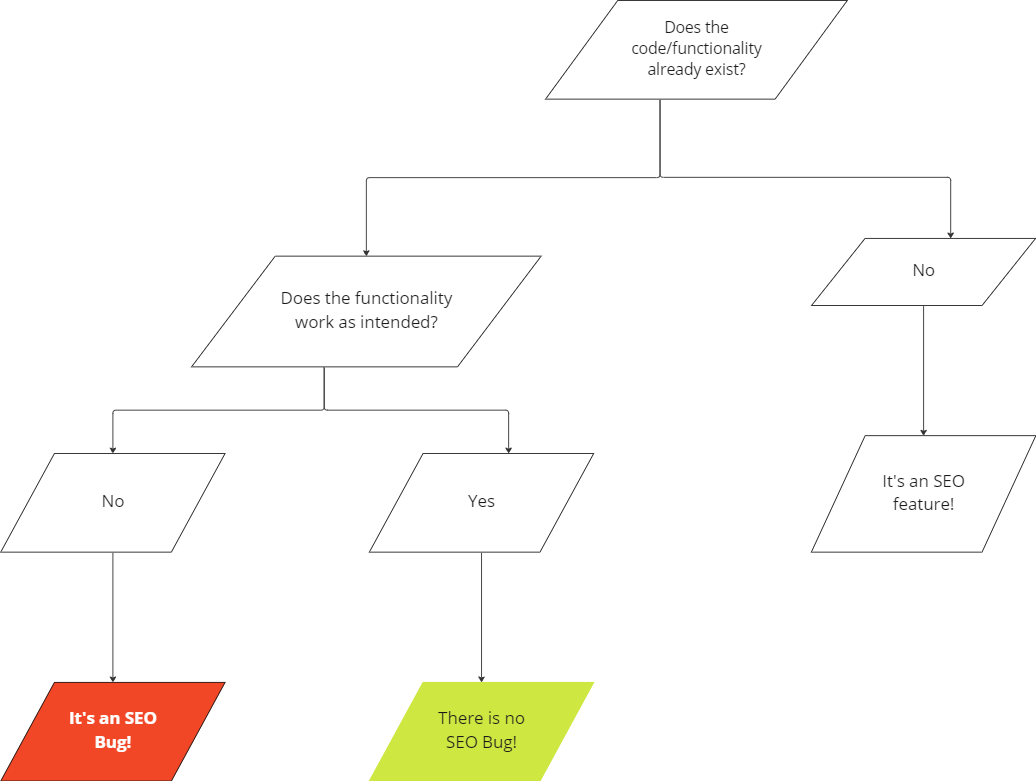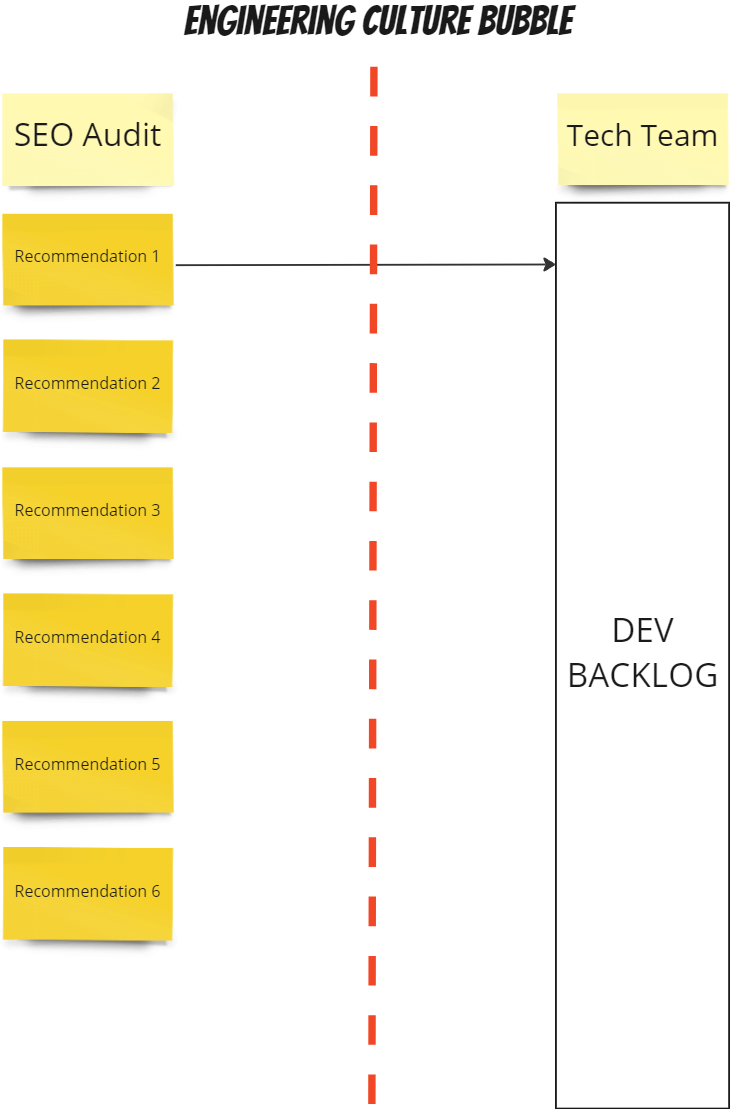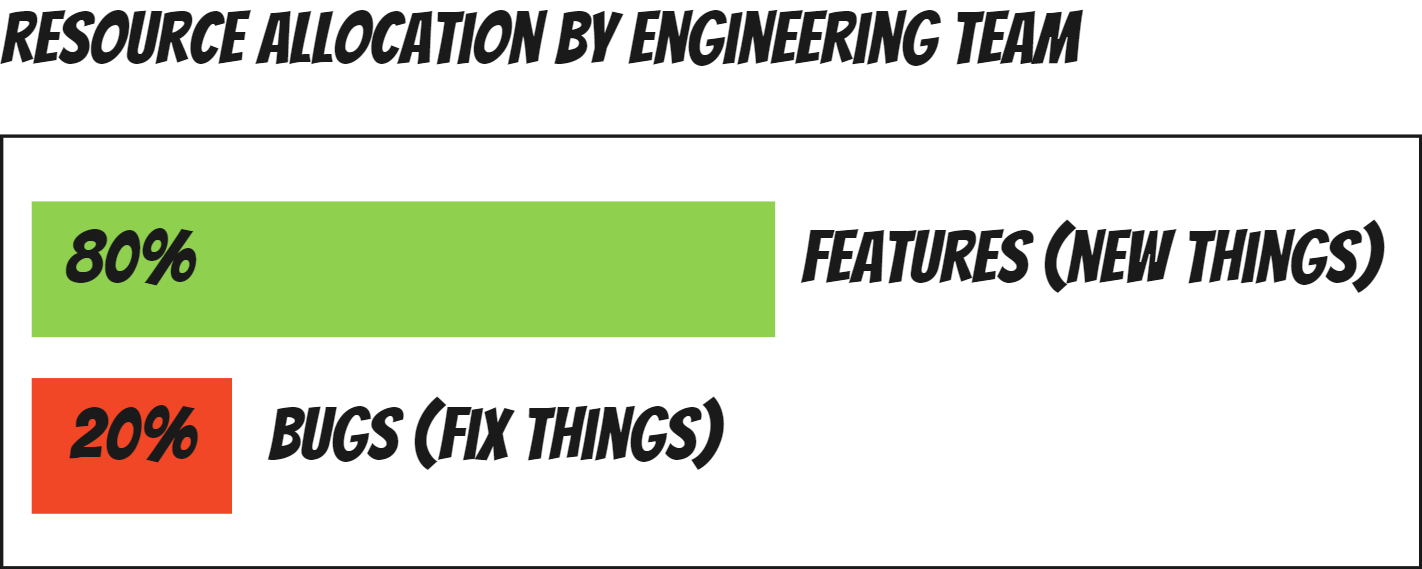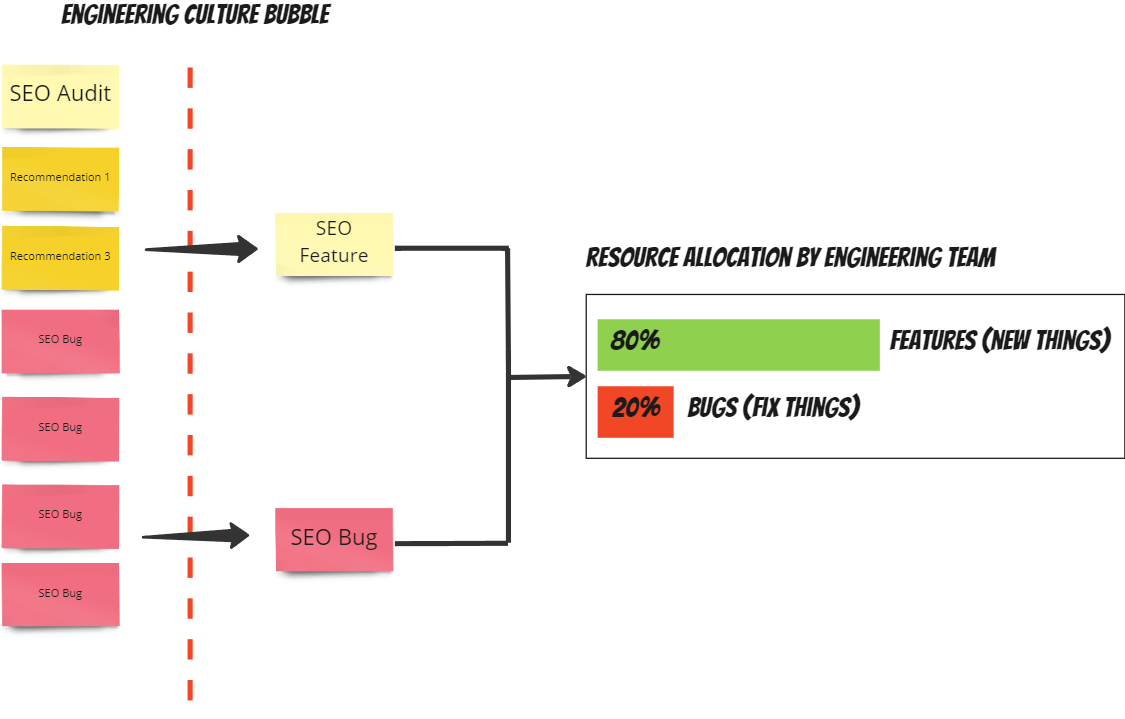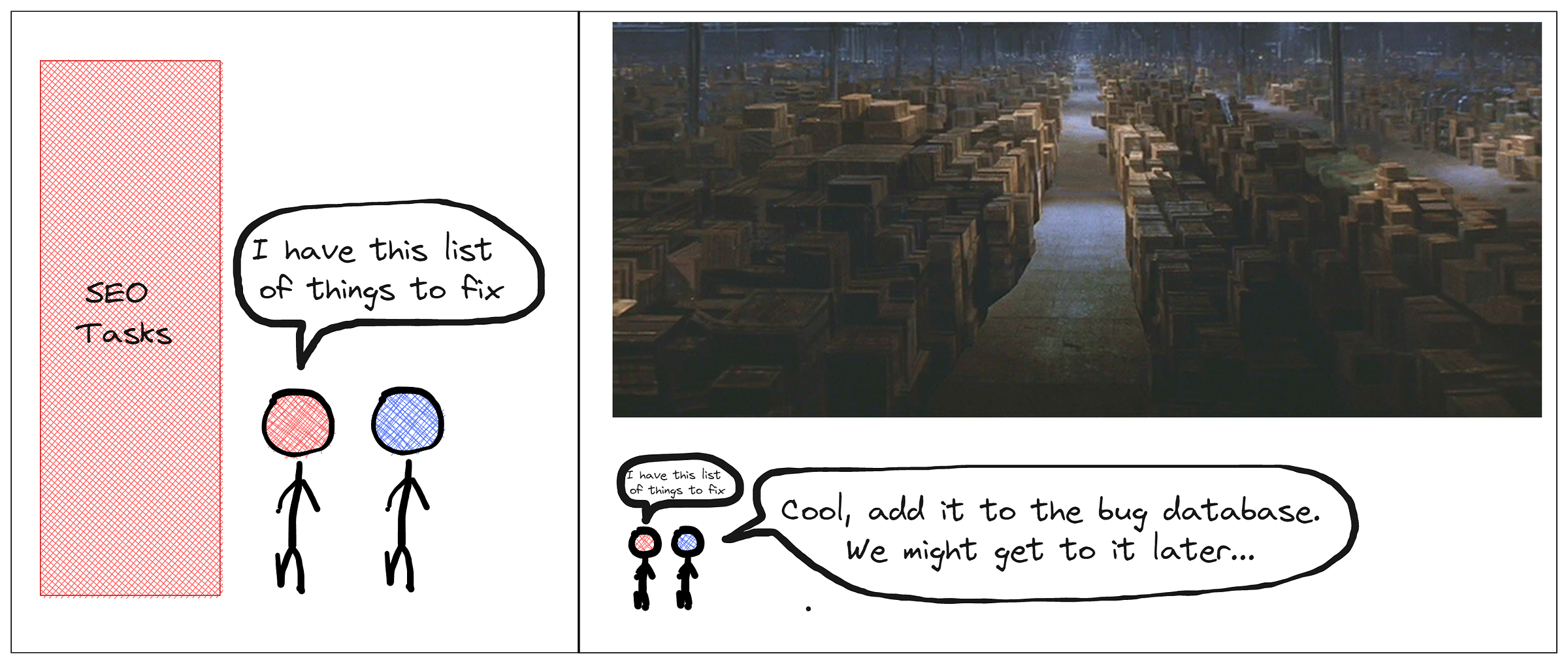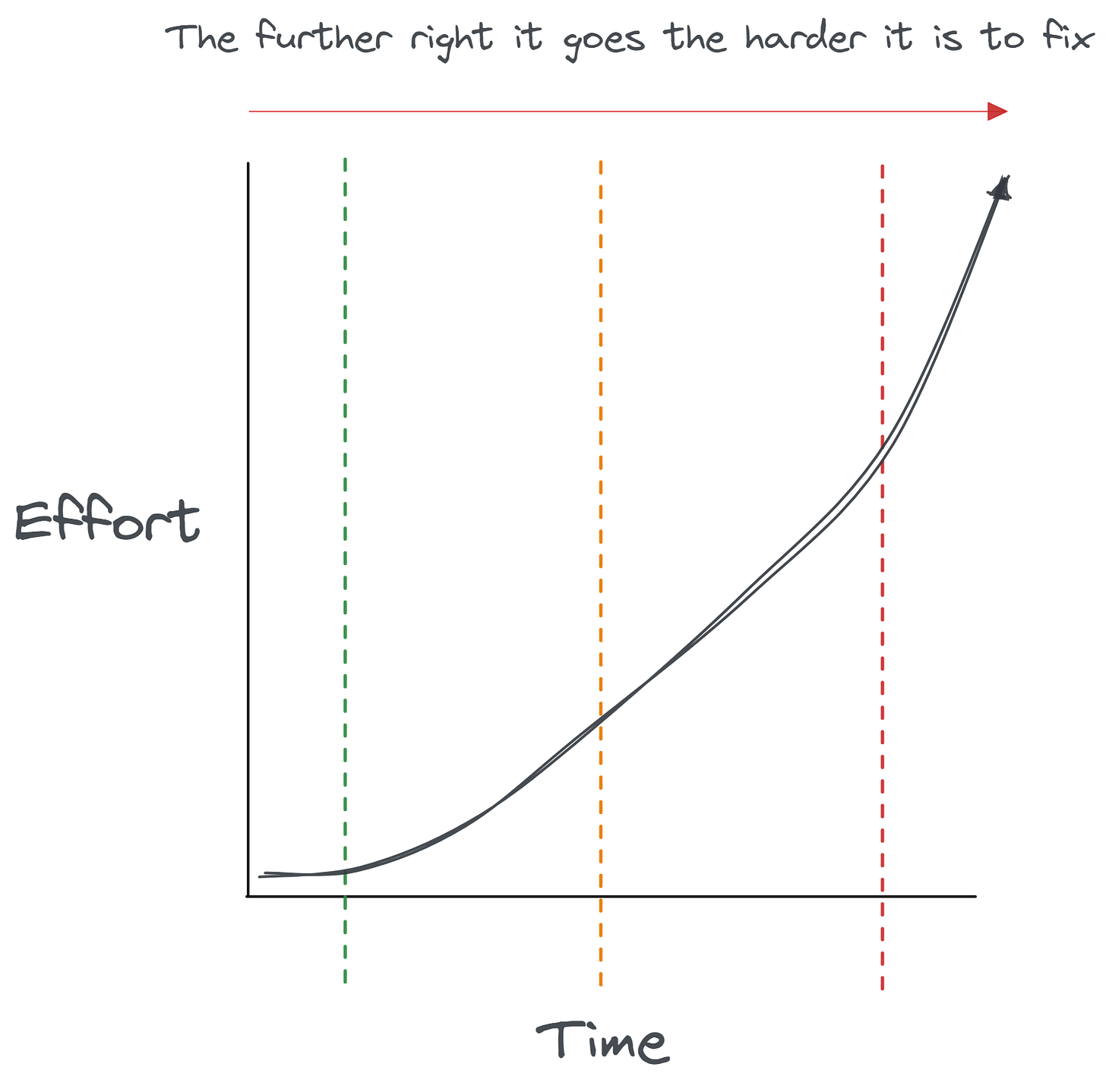A weekly newsletter that provides practical advice for SEOs on how to work with product and development teams.
If you want to help improve The SEO Sprint please feel free to leave feedback!
Not all SEO recommendations are created equal.
In product and engineering teams there is a constant need to prioritise two key types of output:
Bugs
Features
Features are the key to driving growth within any organisation that relies on engineering teams.
Interestingly, fixing bugs in any system is viewed as less of a priority. Even though it can help to reduce costs and help solve customer problems.
For any SEO it is critical to understand the difference because it can help you get things done.
In this week’s newsletter we are going to cover:
🐾 What is an SEO feature?
🐛 What is an SEO bug?
🤷 What is the difference?
📈 Why is it important to know the difference?
✨ How can SEOs get features or bugs implemented
🐾 What is an SEO feature?
An SEO feature is a set of functionality that helps search engines crawl, index and rank content that is intentionally built.
For example, the following are considered SEO features:
Creating XML sitemaps for a large ecommerce website
Adding HREF lang tags to international websites
Automatically compressing images when uploaded to a CMS
In fact, when SEOs recommend new changes to any platform, CMS or application this is, in theory, an SEO feature.
WordPress Example
WordPress is an excellent example of this. As a website owner, you can quickly add plugins that can help you optimise your website by adding features such as:
Schema markup generator
Post or Page metadata management
Post or Page Open Graph Protocol management
SEO Health score for blog posts
Ability to install Google Search Console or Bing Webmaster Tools
Built-in Analytics and Rank Tracking
Index management for tags, posts, and author pages
Robots.tx management
And many more!
WordPress by default is lacking in basic SEO features and plugins (a feature) are a way for website owners to quickly install new bits of functionality that make their life easier.
🐛 What is an SEO bug?
An SEO bug is an error usually caused by human error from the technical team or miscommunication which results in something being deleted.
For example, the following are considered SEO bugs:
Removal of HREF Lang tags in a code release
Adding a noindex tag to the homepage (classic)
A live page returning a 404 HTTP status code
It is important to understand that bugs are inevitable in any system, website or codebase.
The reality is that many engineering teams would never have any time to build anything new if they turned around and fixed all the bugs in a system.
The same happens with SEO bugs.
As an SEO team, you are going to have to prioritise what the development team are going to work on. Otherwise, new shiny SEO features will never be worked on and released to production.
🤷 What is the difference?
The difference between SEO features and SEO bugs is quite (in theory) simple:
SEO Features - Adding new functionality to a website or improving on the existing functionality of a system that helps search engines crawl, index and rank a website.
SEO Bugs - Fixing existing SEO features or code that doesn't meet the expected result to help search engines crawl, index and rank a website.
To make it easier to spot if a recommendation is a feature or a bug I created a workflow diagram:
Let's dig into an example to better understand the difference.
XML Sitemaps - Example
An XML sitemap is a good example of either going down the fixing a bug or creating a new feature to help a company grow.
Let’s say you crawl an XML Sitemap and notice that the file is not valid because it exceeds the 50K URL or MB limit. So, you create a bug ticket and state what the expected outcome should be the XML Sitemap needs to meet the 50K URL and MB limit. This is a bug. The current code or system is not behaving as expected.
In contrast, let’s say you wanted to reduce the size of the XML Sitemap from 50K URLs to 10K URLs. Also, you want to create multiple sitemaps for different directories of the website. On a custom platform, these requirements are new bits of functionality that the development team need to build into the system to make the changes.
These changes are a small SEO feature.
📈 Why is it important to know the difference?
So, why is it important for SEOs to understand the differences between an SEO feature vs an SEO bug?
When an SEO creates a list of recommendations they might not understand:
The domain language of the team
The processes when raising problems
The politics within the team
The resource constraints within the team
From the outside, it might seem like a simple case of just moving your recommendations from your documentation to a Jira ticketing system. Then it will get done right?
Well, the reality is that in most engineering and product teams the culture and system can be a lot more complicated.
The product and engineering teams need to prioritise what is being worked on based on the business strategy.
For example, I know that product and engineering teams will allocate 10-20% of the tickets in a Sprint or release cycle to fixing “bugs”.
The rest of the time focuses on building new things (features).
The impact of this constant need to push new interesting things out is that bugs in the system pile up with little time allocated to fixing them.
The growing list of bugs is known as technical debt.
So, why does this all matter to an SEO?
Well, it matters because in product and development teams things that are raised as “bugs” are given less resource allocation than new shiny features that can help grow the company.
When submitting an SEO audit what can happen is that a lot of the recommendations you’ve made are “fixing” things.
All these things might seem small to the SEO but allocating development resources to fixing those bugs can add up. Especially when there is already a huge list of things to fix anyway.
The product and engineering projects which align with the business strategy (and are generally more interesting) will override the list of SEO recommendations.
This adds to the growing list of bugs in the system and to the technical SEO debt.
✨ How can SEOs get features or bugs implemented?
When getting features or bugs implemented there are a few key differences. Let’s dig into ways that SEOs can get these two types of output implemented.
🐾 SEO Features
Below are tips and advice on working with a development and product team on releasing SEO features.
Understand technical and product team roadmaps
It is important to understand the priorities and roadmaps for other teams in the business.
This is because any recommendation you make is going to be taking away the budget and resources from other teams. If your recommendations can be combined with other teams’ roadmaps then you’ve got a better chance of getting your SEO initiatives implemented.
Remember, a lot of resources and time is allocated toward projects that help drive growth. So, if you can work with other teams to optimise their current features in the pipeline this will help drive growth for organic search traffic.
Recommendations:
What goals and metrics do technical teams care about?
What projects are going to help them achieve their goals?
Is there a way that product and development roadmaps align with SEO?
Identify resource and feasibility limitations
A critical element in getting features implemented is if it’s technically feasible.
It is important to understand the tech stack, team resources and expertise within the organisation. There is no point asking for certain SEO features to be implemented if it’s not technically feasible or there is no resource to carry out the task.
It is important for any SEO to sit down with the development team and understand the system they have built. The discussion will also naturally raise resource constraints and how many developers are actually available to work on the website.
A Tale of Two Teams - Example
For example, I’ve worked with a company that only had 1 call a week to discuss changes to their custom website with a third-party development agency. In contrast, I work with a SaaS company that runs Sprints in an in-house product development team on a weekly basis using a Next.JS framework.
These two organisations are the complete opposite of one another in terms of what can be achieved. The former can make only minor changes to the website, which results in tactical optimisation changes. The latter can make strategic incremental changes to the website and pivot at a moment’s notice if needed.
Unfortunately, what you’ll find is that most development and product teams are going to be stretched for resources. Most have a huge backlog of projects and tasks they want to get through.
In these circumstances, it might be a good idea to look for alternative third-party solutions to get things implemented such as:
Edge SEO technology - SEO tools have advanced a lot over the last 2-3 years with Edge SEO technology being used by a lot of companies to get SEO recommendations implemented.
Content Delivery Networks (CDNs) - Most websites now use Cloudflare, Fastly or Akamai to help improve site speed but these tools are also releasing features which could be helpful in taking work off the table of dev teams.
Recommendations:
What is the release cadence of the development team?
How many resources can be allocated to SEO tickets per release?
Does the organisation have the development capacity to make SEO changes?
How can you work with your dev teams to implement an alternative third-party solution to get SEO recommendations implemented?
Build a strategy, roadmap and prioritise SEO initiatives
Be ready to answer the question WHY.
A lot of SEO teams make the mistake of thinking that product and development teams do not care about being strategic.
As an ex-PM, I can tell you from experience that this is not true.
Technical teams are bombarded with requests and feature ideas all the time. They simply do not have enough time or resources to make changes. So, get ready to have a strong reason WHY an SEO feature should be implemented when asking a development or product team to add it to their to-do list.
This means building a clear SEO strategy and prioritised roadmap which helps to connect the value of SEO initiatives.
Recommendations:
What are the high-priority SEO recommendations to be implemented?
Why are these SEO recommendations important to the business?
Is there clear documentation that explains the overall SEO strategy?
🐛 SEO Bugs
Below are tips and advice on working with a development and product team on fixing SEO bugs.
Understand the team and tech stack
I’d always start by sitting down and getting a basic understanding of the structure of a dev team and the tech stack they are working with.
Although many SEOs recommend using plugins like WappAnalyser, these tools do not provide context or history. Speaking to a developer about the system they’ve built will help you gain a more advanced understanding.
A developer might already be aware of the business blockers to gettings SEO bugs fixed and need another (outside) voice to raise the same problems. I found this to be a common trend for teams in-house an outside consultant listens to more than the internal team.
Martin Splitt and Bartosz Goralewicz discuss speaking to developers before jumping into an SEO audit at length in an SEO & Devs series.
Recommendations:
Speak to the lead developer about the website and technology.
Ask the developer why the CMS or platform is missing SEO features.
Discover the team structure and owner around the codebase.
Understand the bug triage process
In product and engineering teams there is a common ceremony that is used to discuss bugs found in a system.
It is called a defect/bug triage meeting.
This meeting is used by developers, QA testers and the product team to replicate, prioritise and discuss bugs raised by stakeholders (inside and outside the company).
If you are an SEO within an engineering culture that has a defect/bug triage ceremony I would recommend understanding more about this process. Why? Because this is where decisions are made to put dev tickets into either the dev backlog, a sprint or into the bug database.
If you’re not part of these conversations then more than likely your SEO bugs will be pushed into the bug database unless there is someone there to argue negotiate why it is a priority.
If you’re in a smaller team and there is no process to discuss bugs then I would recommend creating a recurring fortnightly or monthly 30 min meeting with a dev to discuss bugs on the site.
As well as joining meetings, it is important to build a common language on what is a priority bug. Areej AbuAli has created a great guide on creating clear language around what is a ticket and what isn’t.
Recommendations:
What are the priority SEO bug tickets that need to be solved?
When should I join a bug triage meeting?
Do you have a common language around bug priorities?
Prioritise and pick your battles
Product and engineering teams' cultures can be very resistant to fixing things.
So, when creating a list of recommendations to fix SEO bugs in the system, you’ve got to be prepared to answer the question WHY. This might be with official documentation, forecasting or quotes from Googlers.
Also, when you’re putting together a list of SEO bugs is important to prioritise the list into high - low priority based on impact. Then make sure you understand the context, history and politics around the list.
Not all the recommendations you raise are going to be a priority or will move the needle for business results. So, it is important to pick your battles over which bugs you need to get fixed because you’ll face resistance and they won’t all get implemented.
Remember, there are usually a lot of bugs in a system and the team will need a compelling reason to prioritise this fix over others.
Recommendations:
What are the high - low priorities in your list of recommendations?
What is the compelling reason for your list of bugs to be fixed?
Which of your recommendations are worth fighting for to get fixed?
SEO Monitoring and QA testing
Bugs and defects are neverending. They will always crop up in any system.
Always.
Creating an SEO monitoring and SEO bug process with your development team can help you manage any priority bugs and get them fixed.
The longer a bug is not fixed the greater the chance it won’t be actioned by the development team.
So, it is critical to make sure to have SEO monitoring in place to make sure you can pick up SEO bugs which can be pulled into the bug triage meetings. Bugs usually happen after a code release to production by the development team.
Also, SEO teams also do manual testing in staging environments before changes are released to the public website. Advanced technical teams use automated QA testing to ensure code quality is kept high and simple bugs do not slip through to the production environment.
Recommendations:
How frequently does the development team make changes to the website?
Do you have a local or cloud crawling tool frequently crawling your website?
When can the SEO team do QA testing before a code release to production?
📌 Summary
When trying to get SEO recommendations implemented remember:
SEO features - A recommendation that requests a development team to add new functionality to a website is called a feature.
SEO bugs - A recommendation that requests an existing piece of functionality or code be fixed is called a bug.
Why is it important to know the difference - Product and engineering teams treat bugs very differently, features are prioritised over bugs.
Getting bugs implemented - Although bugs might seem a simple fix, the culture and process of the tech team might make it harder to be implemented.
Getting features implemented - The product and development team have a large backlog of things they want to get implemented, so it is very important that any “new” SEO features have an explanation as to WHY it is important to work on.
📚 Further Reading
Read: Outcome-Driven Roadmaps - A newsletter written by me on the importance of creating roadmaps which connect strategy with development reality.
Read: What are product features? - A quick read on what exactly are product features and how product teams prioritise them to grow a business.
Read: Defining Your Website's SEO Quality Assurance Suite: QA for SEO - A great article from The Grey Company around SEO QA testing.
Watch: Why we need to talk about audits - A discussion between Martin Splitt and Bartosz Goralewicz on the importance of speaking to developers before an audit.
Read: Backlog Management for SEOs - A newsletter by me on the importance of using backlog management to get initiatives implemented by a development team.
📋 Newsletter Feedback
How did I do this week?
If you enjoyed reading this article then consider the following:
📰 Share — Please share the newsletter with your network or colleagues if you think they might find it useful!
✉️ Subscribe to The SEO Sprint newsletter — if you haven’t already then please consider subscribing to the newsletter.



